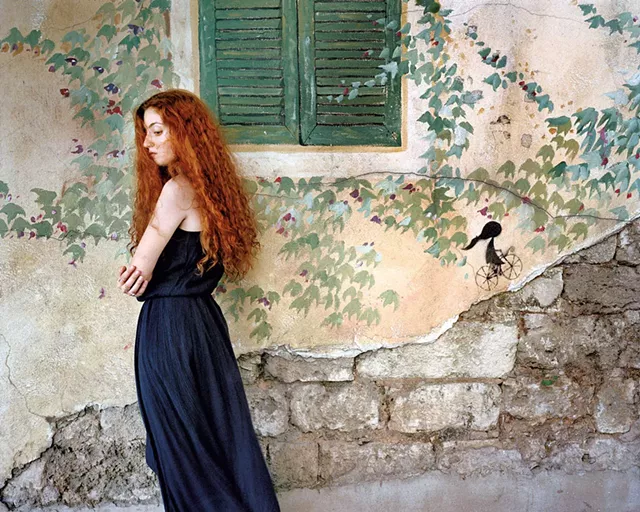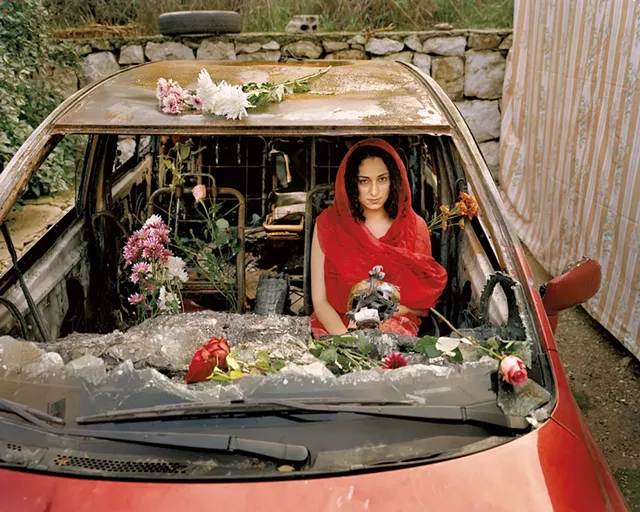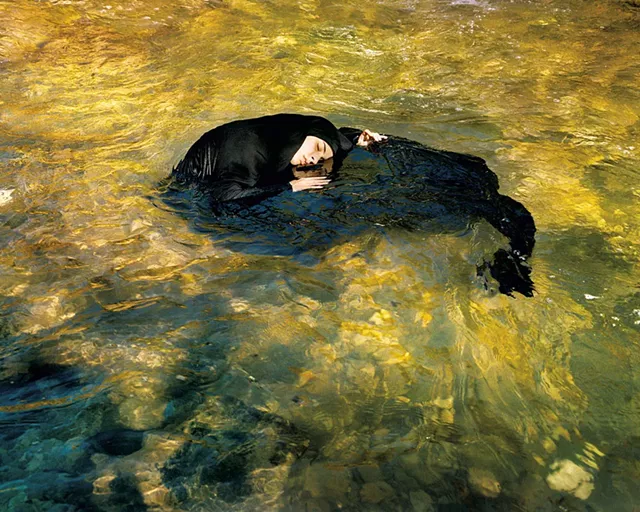Female beauty is on display in “SHE,” a touring exhibition at the Middlebury College Museum of Art. But in Rania Matar‘s large-scale color photographs, beauty is not just skin-deep.
The subjects are lovely, luminous young women depicted alone or in pairs. Their hair is long and loose; feet are bare. And where faces are visible, none is smiling. Matar has captured these women entering the portal of adulthood; they appear to embrace their wayfinding with introspection and quiet confidence.
Matar, a Lebanese American photographer based in Boston, is an associate professor at the Massachusetts College of Art and Design. Born in Beirut, she and her family fled the country’s civil war in 1984, but she continues to revisit and take pictures in the Middle East — including at refugee camps not far from her birthplace.
For her “SHE” project, Matar chose settings in Lebanon, Egypt, France, Massachusetts and Ohio. Each composition is as much a portrait of place as of a person: the Mediterranean shore, a once-grand building mutilated by bombs, a summer meadow, an urban enclave rife with graffiti.
Significantly, the images utterly reject the traditional male gaze with regard to femininity, sexuality and victimhood. They also disrupt stereotypical (mainly Western) assumptions about Middle Eastern and Muslim women. As the collection’s accompanying book puts it: “[Matar’s] art is part of a larger tradition of subversive women artists who speak back to a Eurocentric history of subjugation and possession.”
The book’s introduction describes Matar as a “wanderess” — a passionate traveler and pursuer of experiences. Her interest in photographing women began with her own twin girls; previous projects documented their childhood and adolescence. “Photographed with their belongings, her models expressed angst, shyness, confidence, and a developing sense of selfhood,” the text explains.
Matar began the series that would become “SHE” when her daughters left for college. These images, according to her book, “reveal a more fully realized physicality as the women come of age, forming complex relationships with environments outside the familiarity of their childhood homes.”
Jodi Rodgers, curator of collections and director of engagement at the Middlebury museum, noted in a phone call that, for Matar, her subjects are not simply models; they are collaborators. The artist encouraged their participation and agency.
The “SHE” project began during an artist residency at Kenyon College, where Matar met students who “had a sense of detachment — away from home for the first time,” Rodgers said. “She became interested in connecting with [them].”
Following this residency, Matar garnered a Guggenheim Fellowship and continued shooting the series in Massachusetts and Lebanon. Regardless of location, her concept and aesthetic are remarkably cohesive.
“Nour #1, Beirut, Lebanon” features a woman in profile positioned to the left of the frame and outside an unidentified building. Nour’s thick red hair is a striking contrast with her long navy dress and creamy skin. Her hands cradle her elbows; she gazes pensively downward. The plaster wall, painted with a trompe l’oeil shuttered window and botanical elements, is torn at a diagonal from the lower left. A small, Banksy-like stencil of a girl riding a bicycle heads “uphill” along the edge of the plaster — a humorous but symbolic semaphore of girl power.
“Lea, La Maison Rose” presents a woman with dark hair and eyes, wrapped in a black lace shawl, on the balcony of a shelled mansion. She also stands in profile but casts a sidelong glance into the camera. Her expression is hard to read: Lea looks fierce but wary, perhaps lamenting the ruin around her. Matar’s composition provides a subtle counterpoint in the distance: the flat horizon of the Mediterranean Sea.
Many of the images from Lebanon plainly reveal the wreckage of warfare, and none more than “Farah, Aabey, Lebanon.” Dark-haired Farah, partially covered in a vivid red scarf, fixes a penetrating look from the driver’s seat of her bombed-out red car. Flowers are arranged in place of the missing windshield and passenger seat. The steering wheel seems to have vaporized in the blast.
In the dreamiest image on view, “Aya, Batroun, Lebanon,” a woman lies in shallow water within a craggy rock formation by the sea. She’s wearing a long white dress with spaghetti straps and embroidered details. The scene is shot at a diagonal, so that Aya’s head points to the upper right of the frame, auburn hair drifting gently. Her head is tilted back, throat exposed to golden sun filtering in from her right; her eyes are closed. Aya is so blissfully secure in her repose that viewers might find their own tension melting away.
In addition to voluminous hair and serious faces, Matar employs the color red as a common motif. It is sometimes subtle — a dropped scarf, leafless twigs, painted fingernails. It’s bold in “Eva, East Boston.” Standing with her back to the camera, Eva has long red tresses, wears a short red dress, and is next to a scarred, orange-red expanse of metal. In dramatic contrast, the rest of the scene is bleak — a corrugated warehouse door, black letters spray-painted on a concrete-block wall, a pile of dirt and debris on the ground.
Matar has a keen eye for both natural and manmade environments that serve her thematic objective: witnessing women claim their space in what is often a male-battered world. But sometimes serendipity has its way. One of the most painterly images in the exhibit is “Alae (in the Golden Water), Khia, Lebanon.” Alae floats in water, her black abaya swirling around her. She rests her head, with eyes closed, on a stone. Matar caught a moment when sunlight turned the sea into glittering gold. The shot is tight, with no other context. Alae is serene, while the water dances like brushstrokes.
The exhibition schedule of “SHE” coincides with the 50th anniversary of the Lebanese Civil War. Matar’s signature portraits celebrate a blossoming generation of women tied to, but not restricted by, history.



